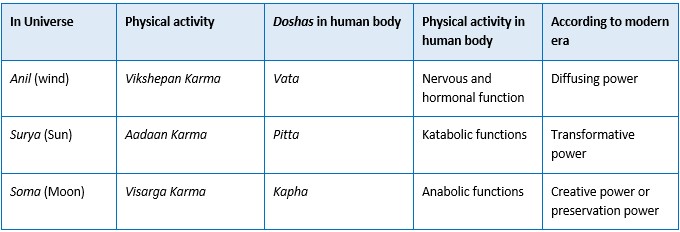Principle of Lok-Purush Samyata w.s.r. to Homeostasis - A Review
DOI:
https://doi.org/10.21760/jaims.9.1.11Keywords:
Lok-Purush Samya Siddhanta, Panchmahabhut, Homeostasis, Dosha Dhatu Samyata, AyurvedaAbstract
Man is a unique structure of the world, the structure that we see today has been continuously evolving. The structures that we see in the universe is made up of some elements, same elements could be seen in the human body structure. Everything that is in the universe is also present in the human body. Charak Samhita named this principle as Lok Purusha Samya. When there are changes in the external environment, then the environment automatically tries to return to its previous state, similarly in the human body too, when there are changes in its internal environment, then the body again returns to its previous state. An attempt is made to bring the internal environment into equilibrium, the same phenomenon is called homeostasis. The preservation of the internal environment in response to changes in the external environment is known as homeostasis. Three elements - the sun, moon, and air - maintain this cosmos in the exterior environment. The three energies of Vata, Pitta, and Kapha maintain our body in the same way as the universe. Furthermore, the fundamentals of our body are Doshas, Dhatus, and Malas. Thus, homeostasis in Ayurveda refers to the state of equilibrium between Doshas, Dhatus, and Malas, which stand for our internal environment. This article attempts to review and explain the significance of Lok-Purush Samya Siddhanta in preserving the internal environment (homeostasis). This idea also applies to the concepts of treatment, which is nothing more than the restoration of homeostasis, the body's natural state.
Downloads
References
Srimadvagbhata. Astanga Hridya. Tripathi B, editor. Delhi: Chaukhamba Sanskrit Pratishthan; 2007. SutraSthan 11/1. p. 160.
Agnivesha. Charaka Samhita. Shukla AV, Tripathi RD, editors. Delhi: Chaukhamba Sanskrit Pratishthan; 2005. Vol. 1. Shareer Sthan 5/3. p. 742.
Agnivesha. Charaka Samhita. Shukla AV, Tripathi RD, editors. Delhi: Chaukhamba Sanskrit Pratishthan; 2005. Vol. 1. Shareer Sthan 4/13. p. 729.
Agnivesha. Charaka Samhita. Shukla AV, Tripathi RD, editors. Delhi: Chaukhamba Sanskrit Pratishthan; 2005. Vol. 1. Shareer Sthan 5/7. p. 744.
Agnivesha. Charaka Samhita. Shukla AV, Tripathi RD, editors. Delhi: Chaukhamba Sanskrit Pratishthan; 2005. Vol. 1. Shareer Sthan 5/5. p. 743.
Agnivesha. Charaka Samhita. Acharya YT, editor. Varanasi: Chaukhambha Surbharati Prakashan; 2008. Shareera sthana 4/13. p. 318.
Maharishi Sushruta. Sushruta Samhita. Shastri KA, editor. Varanasi: Chaukhamba Sanskrit Sansthan; 2016. Vol. 1. Sutra Sthan 14/8-9. p. 65.
Maharishi Sushruta. Sushruta Samhita. Shastri KA, editor. Varanasi: Chaukhamba Sanskrit Sansthan; 2016. Vol. 1. Shareer Sthan 3/2-3. p. 26.
Agnivesha. Charaka Samhita. Shukla AV, Tripathi RD, editors. Delhi: Chaukhamba Sanskrit Pratishthan; 2005. Vol. 1. Shareer Sthan 5/4. p. 742.
Maharishi Sushruta. Sushruta Samhita. Shastri KA, editor. Varanasi: Chaukhamba Sanskrit Sansthan; 2016. Vol. 1. Sutra Sthan 21/8. p. 114.
Agnivesha. Charaka Samhita. Shukla AV, Tripathi RD, editors. Delhi: Chaukhamba Sanskrit Pratishthan; 2005. Vol. 1. Viman Sthan 3/6. p. 568.
Agnivesha. Charaka Samhita. Shukla AV, Tripathi RD, editors. Delhi: Chaukhamba Sanskrit Pratishthan; 2005. Vol. 1. Sutra Sthan 11/43.
Maharishi Sushruta. Sushruta Samhita. Shastri KA, editor. Varanasi: Chaukhamba Sanskrit Sansthan; 2016. Vol. 1. Sutra Sthan 14/7. p. 65.
Maharishi Sushruta. Sushruta Samhita. Shastri KA, editor. Varanasi: Chaukhamba Sanskrit Sansthan; 2016. Vol. 1. Shareer Sthan 4/62. p. 49.
Agnivesha. Charaka Samhita. Shukla AV, Tripathi RD, editors. Delhi: Chaukhamba Sanskrit Pratishthan; 2005. Vol. 1. Sutra Sthan 9/4. p. 149.
Agnivesha. Charaka Samhita. Shukla AV, Tripathi RD, editors. Delhi: Chaukhamba Sanskrit Pratishthan; 2005. Vol. 1. SutraSthan 1/44-45. p. 13.














